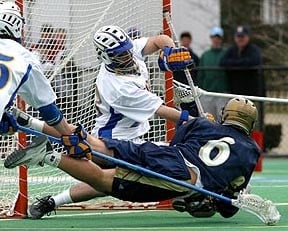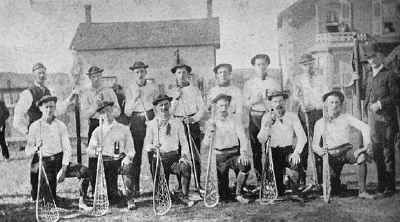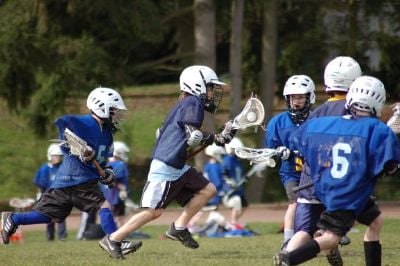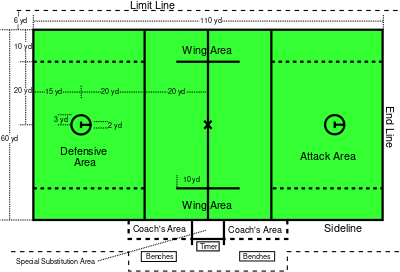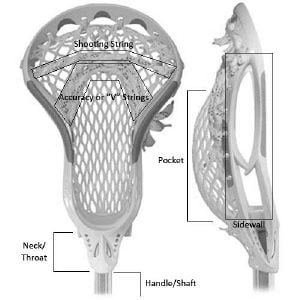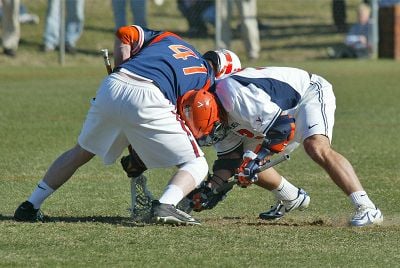Lacrosse
Lacrosse is a team sport that is played with ten players (men's field), six players (men's box), or 12 players (women's field), each of whom uses a netted stick (the cross) in order to pass and catch a hard rubber ball with the aim of scoring goals (each worth one point traditionally, but Major League Lacrosse uses a two point goal for goals scored from a distance of 16 yards or greater) by propelling the ball into the opponent's goal. The team scoring the most points after two halves, of varying length from competition to competition, and overtime if necessary, wins.[1][2][3]
Most popular in North America, lacrosse is Canada's national summer sport. It has grown in popularity in the United States, becoming the fastest growing sport at the high school and NCAA levels.
In its current form, men's lacrosse is played on a field of grass or artificial turf (such as FieldTurf). Each team is composed of ten players on the field at a time: three attackmen, three midfielders, three defenders and one goaltender. In men's lacrosse, players wear protective equipment on their heads, shoulders, arms, and hands, as body-checking is an integral part of the game, and stick checks to the arms and hands are considered legal. Women's lacrosse is played in a similar manner except with two additional midfielders per team. Players of women's lacrosse (in the United States only) need only wear protective eyewear (except for the goaltender, who wears additional padding, usually consisting of a helmet, shin guards, and chest pad, and most goalies do not wear arm pads), as contact is not permitted apart from minor stick-checks.
History
Lacrosse was invented by Native North Americans. According to Joe Finn, archivist at the National Lacrosse Hall of Fame and Museum, “Lacrosse was an integral part of Native Americans’ culture. It was played to prepare them for war, and it was also a social event where tribes would get together for trade and sport. It was sometimes used to settle disputes."[4]
The game was named lacrosse by early French spectators. It is widely and inaccurately believed that the name stems from the French term "cross," for the shepherd's crook-like crosier carried by bishops as a symbol of office. Jesuit missionary Jean-de-Brébeuf noted the resemblance between the crosier and the shape of the racket stick in the Relation des Jésuites around 1640. In fact, the term cross is a general word in French for any type of bat or stick used in a ball game. The name lacrosse is simply a reflection of this term, and perhaps a shorthand for a phrase such as jeu de la cross (the game of the hooked sticks).[5]
Lacrosse traditionally had many different purposes. Conflict resolution and training of young warriors was only one part of the game. Games could be played on a pitch over a mile wide and sometimes lasted for days. Often players were gravely injured or even killed. Early balls were made out of the heads of the enemy, deerskin, clay, stone, and sometimes wood. Lacrosse has played a significant role in the community and religious life of tribes across the continent for many years. Early lacrosse was characterized by deep spiritual involvement, befitting the spirit of combat in which it was undertaken. Those who took part did so in the role of warriors, with the goal of bringing glory and honor to themselves and their tribes, and as a religious ritual: "Some Native Americans believe the sport was a gift from the Creator to be used for enjoyment and as medicine."[4]
Lacrosse has witnessed great modifications since its origins in the fifteenth century, but many aspects of the sport remain the same. In the Native North American version, each team consisted of about 100 to 1,000 men on a field that stretched from about 500 yards to a couple of miles long. Many of the Native teams used trees or other natural features as goals which the deerskin ball had to pass through. These lacrosse games lasted from sun-up to sun-down for two to three days.The game became known to Westerners when a French Jesuit Missionary, Jean de Brébeuf, saw the Iroquois Natives play it in 1636.[6]
By the nineteenth century, lacrosse evolved to a less violent game and more of a sport as French pioneers began competing. In 1856, Dr. William George Beers, a Canadian dentist, founded Montreal Lacrosse Club and in 1867 he codified the game, shortening the length of each game and reducing the number of players to ten per team.[6] The first game played under Beers' rules was at Upper Canada College in 1867, with Upper Canada College losing to the Toronto Cricket Club by a score of 3–1. By the 1900s, high schools, colleges, and universities began playing the game, and lacrosse was contested as a medal sport in the 1928 and 1932 Summer Olympics.
In the 1930s, an indoor version of the game, box lacrosse, was introduced in Canada. It quickly became, and remains, the dominant form of the sport in that country. A later version of box lacrosse, indoor lacrosse, is played professionally in both Canada and the United States.
In the United States, the sport enjoys its greatest popularity along the east coast, especially in Maryland (where it became the state's official team sport in 2004), Delaware, New York, New Jersey, Pennsylvania, Virginia, and the New England states. However, its popularity has started to spread west to Colorado, California, Texas, and the Midwest, spurred by the sport's increasing visibility in the media, the growth of college and high school programs, and youth or "pee wee" leagues throughout the country. Currently, there are only two NCAA Division I men's lacrosse teams west of the Mississippi River: Air Force and the University of Denver. The growth of lacrosse was also facilitated by the introduction of plastic heads invented by Baltimore-based stick maker STX in the 1970s. This innovation reduced the weight and cost of the stick, and allowed for faster passes and gameplay.
Men's lacrosse
Outdoor men's lacrosse involves two teams of ten players each competing to project a small ball of solid rubber into the opposing team's goal. The field of play is 110 yards (100 m) long and 60 yards (54 m) wide. The goals are 6 feet (1.8 m) by 6 feet, containing a mesh netting similar to an ice hockey goal. The goal sits inside a circular "crease," measuring 18 feet (5.5 m) in diameter.[1] Behind the crease is the area designated simply as "X." Typically one Attackmen will remain at "X" in most types of offensive setups.
Players line up with three offensive players called "attackmen," players who shoot on the opposing team's net; three "midfielders" or "middies," who shoot on the opposing team's net as well as defending their own net; three "defensemen," who guard their own team's net; and 1 designated goaltender, or "goalie" who stands inside the "crease" and blocks incoming shots. Each player carries a lacrosse stick measuring between 40 inches (101.6 centimeters) and 42 inches (106.68 centimeters) long (a "short cross"), or 52 inches (132.08 centimeters) to 72 (182.88 centimeters) long (a "long cross"). The designated goalkeeper is allowed to have a stick from 40 inches (101.6 centimeters) to 72 inches (182.88 centimeters) long. The head of the cross on both long and short crosses must be 6 inches or larger at its widest point and 2.5 inches wide or wider at its narrowest point.[1]
The head of a goaltender's cross may measure up to 15 inches (38.1 centimeters) wide, significantly larger than field players' heads to assist in blocking shots. Goalies at the youth levels commonly use short crosses because they are not capable of handling the true 60 inch goalie cross. Although most attackmen and midfielders utilize short crosses, defensemen carry long crosses, and one midfielder on defense may carry a long cross.[1] Some teams choose to distribute their sticks differently, not uncommon because a team may only have four long crosses on the field during live play, excluding the benches and penalty boxes. Most modern sticks have a metal shaft, usually made of aluminum or titanium, while the head is made of hard plastic. Metal shafts must have a plastic or a more popular rubber cap or ("butt") at the end. The heads are strung with string, leather, and mesh. The strings in the "pocket" are called shooting strings and accuracy or "v" strings.
Lacrosse players must wear helmets and gloves and also typically wear shoulder and elbow pads and sometimes they wear rib pads.[2] Athletic supporters and protective cups for all players are also strongly recommended and often required.
Players scoop the ball off the ground and pass the ball through the air to other players. Players are allowed to run carrying the ball with their stick. Unlike in women's lacrosse, men's lacrosse players may kick the ball, as well as cover it with their sticks, provided they do not withhold it from play. Play is quite fast and fluent, with considerably more goals scored than are in soccer or hockey, with typical games totaling ten to twenty goals.
Positions
- Attackmen: There are three Attackmen on the field at one time. The Attackmen use "short-sticks." Attackmen must demonstrate good stick-handling with both hands and they must be able to handle the pressure of the opposing defenseman and they are also the people who score goals.
- Defensemen: There are three Defensemen and one long stick midfielder allowed on the field at a time. Defensemen use "long-poles." The Defensemen uses his stick to throw checks and try to dislodge the ball. The "long-poles" may also play mid-field as a strategic defender, aka a Long-stick middie (LSM). Teams usually use this to anticipate losing the face-off and be stronger on defense.
- Midfielder: Commonly referred to as "middies," three Midfielders are allowed on the field at once. There are two types of Midfielders, the defensive and offensive. The two can rotate by running off the sidelines. The Midfielders are allowed to use short-sticks and up to one long-pole. While on offense three short-sticks are generally used for their superior stick-handling. While on defense two short-sticks are used with one long-pole. Some teams have a designated face-off middie that takes the majority of face-offs and is usually quickly substituted after the face-off is complete.
- Goalkeeper: The goalkeeper's job is to prevent the ball from getting into the goal. Goalies also direct the team defense. Goalies need to be tough both physically and mentally. Also the Goalie needs to be the loudest player on the field calling the position of the ball at all times so the defense can concentrate on the man they are covering instead of where the ball is. The Goalie needs to be able to keep his composure on the field while enduring pain from shots that are capable of reaching over 100 MPH.
Rules
Since men’s lacrosse is a full contact sport, with players wearing complete protective equipment, “checking”—striking opponents’ stick or body with the stick—is legal and very much part of the game.
Each team starts with ten players on the field: a goalkeeper and three defenders in the defensive end; three midfielders free to roam the whole field; and three attackers in the offensive end. Each quarter starts with a “face-off” in which the ball is placed on the ground and two “face-off-men” lay their stick horizontally next to the ball, head of the stick inches from the ball and the butt-end pointing down the midfield line. Face-off-men scrap for the ball, often by “clamping” it under their stick and flicking it out to their midfielders, who start on the wing restraining line near the sideline and sprint in when the whistle is blown to start play. Attackers and defenders cannot cross their “restraining line” until one player from the midfield takes possession of the ball.[1] A face-off also restarts the game after each goal.
Time continues to run in dead ball situations such as in between goals, with two exceptions: when the referees deem it necessary to avoid a significant loss of playing time, for example when chasing a ball shot far away or during care of an injured player; and in the last three minutes of the fourth quarter of any men’s game.[2]
In men's lacrosse, players can be awarded penalties of two types by the referee for rule infractions. Personal fouls always result in the player serving time in the penalty box, located at the side of the field between the opposing teams' interchange benches. These penalties can last one to three minutes at the referee's discretion. Two- and three-minute penalties are usually reserved for the most serious slashing or unsportsmanlike conduct fouls. Technical fouls are less severe and result in 30 seconds being served only if the foul was committed while the opposing team was in possession of the ball. If there was a loose ball situation or the player's team was in possession at the time of the foul, they only result in a turnover. Technical fouls are "releasable," meaning that a player may return to the game without spending the entire duration of his penalty in the box if the opposing team scores during the penalty. Fouls form an important part of men's lacrosse as while a player is serving time, his team is 'man down'. At this time his defense usually plays a 'zone' while they wait for the penalty to expire while the attacking team has its best opportunity to score. A list of the fouls in men's lacrosse is as follows:
Personal fouls
- Slashing: Occurs when a player hits another player uncontrolled, in the back, below or on the knees, or in the helmet/neck.
- Tripping: Occurs when a player obstructs his opponent at or below the waist with the cross, hands, arms, feet or legs.
- Cross Checking: Occurs when a player uses the handle of his cross between his hands to make contact with an opponent.
- Unsportsmanlike Conduct: Occurs when any player or coach commits an act which is considered unsportsmanlike by an official, including taunting, arguing, or obscene language or gestures.
- Unnecessary Roughness: Occurs when a player strikes an opponent with his stick or body using excessive or violent force.
- Illegal Body Checking: Occurs when any of the following actions takes place:
- a. body checking an opponent who is not in possession of the ball or within five yards of a loose ball.
- b. avoidable body check of an opponent after he has passed or shot the ball.
- c. body checking an opponent from the rear or at or below the waist.
- d. body checking an opponent above the shoulders. A body check must be below the shoulders and above the waist, and both hands of the player applying the body check must remain in contact with his cross.
- Illegal Cross: Occurs when a player uses a cross that does not conform to required specifications. A cross may be found illegal if the pocket is too deep or if any other part of the cross was altered to gain an advantage, such as the stick being shorter than the required length in order to make it harder to check. (In addition, the penalized player may not use the illegal cross for the remainder of the game). A head must also not be too pinched so the lacrosse ball cannot come out.
- Other Illegal equipment: not having a mouthguard, or not having it in the mouth, open ends on the shaft of the stick (no butt end), no shoulder pads, no arm pads (in most leagues, goalies do not have to wear arm pads so they can move their arms faster to block shots. The minimum amount of pads a goalie needs are helmet, throat guard, gloves, chest protector,and cup)
- Illegal Gloves: Occurs when a player uses gloves that do not conform to required specifications. A glove will be found illegal if the fingers and palms are cut out of the gloves, or if the glove has been altered in a way that compromises its protective features.[1]
Technical fouls
- Holding: Occurs when a player impedes the movement of an opponent or an opponent's cross, or a player has his cross in between the arm pads and the players body.
- Interference: Occurs when a player interferes in any manner with the free movement of an opponent, except when that opponent has possession of the ball, the ball is in flight and within five yards of the player, or both players are within five yards of a loose ball.
- Offsides: Occurs when a team does not have at least four players on its defensive side of the midfield line or at least three players on its offensive side of the midfield line.
- Pushing: Occurs when a player thrusts or shoves a player from behind.
- Moving Pick: Occurs when an offensive player moves into and makes contact with a defensive player with the purpose of blocking him from the man he is defending, as opposed to a legal pick, standing next to a defensive player, blocking him from the player he is covering.
- Stalling: Occurs when a team intentionally holds the ball, without conducting normal offensive play, with the intent of running time off the clock. This is called if no attempt is made to get in the box.
- Illegal Start: Occurs when a wing player passes the wing sideline before the faceoff whistle blows.
- Time Delay: (Goalie Only) When the Goalie is in possession of the ball for more than the allotted time while in the crease or fails to clear the ball in the allotted time.
- Warding Off: Occurs when a player in possession of the ball uses his free hand or arm to hold, push or control the direction of an opponent, including pushing him off.
- Mouthguard Fouls: Not having a mouthguard, not having in the mouth or taking in or out of the mouth (also known as chewing on the mouthguard). (Under ILF-Rules no mouth guard is required) [1]
Box lacrosse
Canadians most commonly play box lacrosse, an indoor version of the game played by teams of six on ice hockey rinks where the ice has been removed or covered by turf; the enclosed playing area is called the box, in contrast to the open playing field of the traditional game.[7] This version of the game was introduced in the 1930s to promote business for hockey arenas, and within a few years had almost entirely supplanted field lacrosse in Canada.
In box lacrosse the goal is smaller (4'9" X 4') than in outdoor lacrosse, and the goaltender is usually bigger, with considerably more padding. The attacking team must take a shot on goal within 30 seconds of gaining possession of the ball, and play is rougher than in the field game with the allowance of crosschecking.[7]
Indoor lacrosse is a version of box lacrosse with slight rule changes–the games are played during the winter,[7] not only in regions where summer lacrosse is popular but also in regions where lacrosse is rarely played in summer. This version of the game was intended to be less violent than box lacrosse, although changes in box lacrosse rules have reduced some of its violent play and a change in indoor lacrosse rules to permit crosschecking (hitting another player with the stick with one's hands apart on the shaft) have made it more violent. The chief differences between the two forms of the indoor game now are that indoor lacrosse games consist of 4 x 15 minute quarters compared with 3 x 20 minute periods in box lacrosse, and that indoor lacrosse players may use only sticks with hollow shafts, while box lacrosse permits solid wooden sticks.[7] Indoor lacrosse is always played on artificial turf (sometimes called "carpet"), while box lacrosse is usually played on bare concrete.[7] Comparably, field lacrosse is played on a standard size field.
Today, there are 13 different teams in thirteen different cities playing the National Lacrosse League.
Men's professional league
One of the fastest growing professional sports leagues on the planet, Major League Lacrosse has captivated fans since its inception in 2001. 2006 MLL World Champions the Philadelphia Barrage boast star players midfielder "middie" Roy Colsey, defensemen Kyle Sweeney, goalie Brian Dougherty, and attackmen Ryan Boyle, amongst others. MLL expansion in 2006 has solidified lacrosse hotbeds of Denver, CO (with the Denver Outlaws), and fostered continued growth in Los Angeles (Los Angeles Riptide), San Francisco (San Francisco Dragons), and Chicago (Chicago Machine).
Rochester, New York (Rochester Rattlers), East Brunswick, New Jersey (New Jersey Pride), Washington, D.C. (Washington Bayhawks), Boston, Massachusetts (Boston Cannons), Philadelphia, Pennsylvania—games played in Downingtown, PA (Philadelphia Barrage)—and the Long Island Lizards comprise the "original six franchises" of MLL.
In the 2007 MLL collegiate draft, the first overall selection (by the Chicago Machine) was Pennsylvania State University senior midfielder Patrick Heim. The 2007 Major League Lacrosse Championship was won by the Philadelphia Barrage led by Matt Striebel.
Other leagues
While Major League Lacrosse is growing by leaps and bounds, professional lacrosse is also played at the high school level, collegiate level (NCAA Lacrosse) as well as in the National Lacrosse League.
Women's lacrosse
The rules of women's lacrosse differ significantly from men's lacrosse and are specifically designed to allow less physical contact between players. As a result of the lack of contact, the only protective equipment required is eyewear and a mouthguard.[3] Although these are the only protective equipment, there are still many injuries due to accidental checks to the head and the overall aggressiveness of the sport. The pockets of women's sticks are shallower than those of the men, making the ball harder to catch and more difficult to shoot at high speed. Women play with three attackers (or "homes"), five midfielders (or "middies"), three defenders (starting from the back, called "point," "cover point," and "third man"), and one goalie. Seven players play attack at one time and seven defenders are present. There is a restraining line that keeps the other four players (plus the goalie) from going into the attack. If those players cross the line, they are considered offsides and a penalty is given.[3]
In women's lacrosse, players may only check if the check is directed away from the ball carrier's head. Also, players may only check using the side of their stick. If caught by one of the referees using the flat of the head, it will be called as a "held check" and the opposing team will get the ball.[3]
There are two types of fouls in woman's lacrosse, major and minor. When a minor foul is committed anywhere on the field, the player who fouled is set four meters to whichever side she was guarding the person she obstructed. If a major foul occurs outside of the 12-meter fan or eight-meter arc, the fouler must stand four meters behind the player she fouled.[3]
There are two different surroundings around the goal on both sides of the field. The eight-meter arc and the 12-meter fan. When committing a major foul inside either of these areas, all players that were previously inside the surrounding must take the most direct route out. The player who was fouled now moves to the nearest hash mark that is located around the edges of the arc or fan and either takes position to shoot or to pass (although, most often to shoot). When the whistle is blown, the player with the ball may move up and try for a goal.[3]
The most important rule in women's lacrosse is shooting space—this is a violation of the rules. It occurs when a defender moves in at a bad angle on the offender while shooting in the eight-meter arc. This is a dangerous play made by the defender.
Women's games are played in two 25-minute halves. These 25 minutes are running time, except for the last two minutes, during which time stops when the whistle is blown (This can differ when playing high school or middle school games). While the whistle is blown, players are not allowed to move. In women's lacrosse, players are not allowed to touch the ball with their body or cover the ball with their stick in order to scoop it into their stick or protect the ball from picked up by an opponent.[3]
The women's lacrosse game has been modified significantly in recent years. Modifications include limiting the amount of players allowed between the two restraining lines on the draw to five players per team. Stick modifications have lead to offset heads, which allow the women's game to move faster and makes stick moves and tricks easier. In 2002, goggles became mandatory equipment in the United States (but not a requirement in international rules). In 2006, hard boundaries were adopted.[3]
Penalties for women's lacrosse are assessed with the following cards:[3]
- The green card, given to the team captain, is for a delay of game.
- The yellow card is for a first-time penalty and results in the player being removed from the field for three minutes.
- The red card is the result either of two yellow cards or one unsportsmanlike behavior ruling, and causes the player to be ejected from the game. If the red card is for unsportsmanlike behavior, the player is also not permitted to play in the following game.
The University of Maryland, College Park has traditionally dominated the women's intercollegiate play, producing innumerable head coaches across the country and many U.S. national team players. The Lady Terps won seven consecutive NCAA championships, from 1995 through 2001. Princeton University's women's teams have made it to the final game seven times since 1993 and have won three NCAA titles, in 1993, 2002, and 2003. The game is also commonly played in British girls' independent schools, and while only a minor sport in Australia, it is played to a very high standard at the elite level, where its national squad won the 2005 World Cup.
Women's intercollegiate lacrosse stars have included University of Maryland, College Park standouts Kelly Amonte-Hiller, coach of the 2005, 2006, and 2007 national championship team from Northwestern University, and all-time scoring leader Australian Jen Adams.
International lacrosse
While modern lacrosse has been around for over 100 years, it was played for the most part only in Canada and the United States, with small but dedicated lacrosse communities in Great Britain and Australia. Since then however, lacrosse has flourished at an international level with the sport establishing itself in many new and far-reaching countries, particularly in Europe and East Asia.
With lacrosse not having been an official Olympic sport since 1908, the pinnacle of international lacrosse competition consisted of the quadrennial World Championships. Currently, there are world championships for lacrosse at senior men, senior women, under 19 men and under 19 women level. Until 1986, lacrosse world championships had only been contested by the United States, Canada, England and Australia, with Scotland and Wales also competing in the women's edition. The expansion of the game internationally has seen the 2005 Women's World Cup competed for by ten nations, and the 2006 Men's World Championship was contested by 21 countries. One of the major stumbling blocks to the reintroduction of lacrosse into the Olympic program is the fact that men's and women's lacrosse have completely separate international governing bodies.
In 2003, the first World Indoor Lacrosse Championship contested by six nations at four sites in Ontario, Canada. The 2007 WILC was held in Halifax, Canada. Teams from Australia, Canada, the Czech Republic, England, Ireland, Iroquois Nationals, Scotland and the United States will be competing.
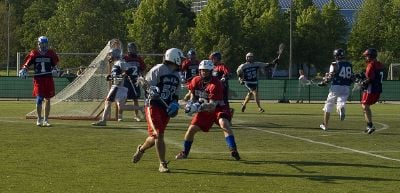
The World Lacrosse Championships have been dominated by the United States, particularly in the men's game, where the only world championship game losses at either level was in the 1978 and 2006 final to Canada. The United States has won eight of the ten senior men's and all five under-19 men's tournaments to date. In the women's game, Australia have provided stiffer competition, even holding a winning record against the United States of six wins to five at senior world championships, plus one draw. Despite this, the United States has won five of the seven senior women's and two of the three under-19 women's tournaments to date, with the other world championships won by Australia, including the 2005 senior women's trophy.
Despite overall North American success, the highest scoring teams in international competition are not from the United States or Canada. In the women's game, a collaboration of Great Britain and Ireland defeated a team from Long Island, New York by a score of 40-0 in 1967.[8] For the men, the highest scoring team was Scotland over Germany, 34-3 in 1994.[8] However, in the World Championships Premier Division (in 2006 it was Blue), the highest score was from the United States, with their 33-2 win over Japan in 1994.[8]
The Iroquois Nationals are a team consisting of members of the Six Nations of the Iroquois Confederacy. The team was admitted to the International Lacrosse Federation (ILF) in 1990. It is the only Native American team sanctioned to compete in any sport internationally. The Nationals placed fourth in the 1998, 2002, and 2006 World Lacrosse Championships. In 2006, the Iroquois Nationals Lacrosse Program signed a partnership with Nike, Inc.[9]
Lacrosse Terminology
- 10-Second Rule- The time allotted to a team to move the ball into the offensive zone when short-handed.
- 30-Second Rule- The time allotted to a team to get a shot on the opponent’s goal.
- Corner Man- The player who plays the corner or shooter positions on offense (also see Corner Position).
- Cradling The rocking motion of the stick used to gain a feel for, and to maintain control of, the ball.
- Crease- An area around the goal that opposing players are forbidden to enter.
- Draw- Pulling and turning the stick during a face-off; used to re-start play after a dead ball.
- Fast Break- A rapid attack which occurs during the transition from offense to defense.
- Man Short- A situation where one team has fewer players allowed on the floor than the opponent (also referred to as short-handed or man-down).
- Man-to-Man- A team defensive strategy where pressure is placed on the ball carrier while the remaining players move off their checks towards the middle of the floor.
- Overload- The strategy of moving one or two extra players into one area of the floor.
- Pick & Roll- The act of setting a pick and then turning to receive a pass.
- Point Man- The player who plays the point position on offense.
- Point Position- A location at the top and center of the floor; this location is taken by the player who is furthest from the goal.
- Power Play- A situation when one team has a player advantage as a result of a penalty.
- Quick Stick- The act of catching and then passing or shooting in one motion.
- Scoop- A method of picking up the ball by accelerating the head of the stick under the ball.
- Side Arm- The act of shooting or passing the ball by swinging the stick through the horizontal plane at the waist.
- Sliding- The act of leaving one’s check to assist a teammate.
- Switch- The act of exchanging checks with a teammate.
- Trap & Scoop- The act of placing the head of the stick over the ball to stop its movement and then scooping the ball into the stick.
- Triple Threat- A position where the stick is held with two hands such that the body is between the stick and the opponent; this position allows the player to pass, shoot, or go around their opponent.
- V-Cut- A one- to three-step move by an offensive player where the defender is first engaged; the offensive player then takes a quick reverse step and moves into the open to receive the ball.
- Weak Side- The side of the floor with the fewest number of players.
- Zone- A defensive strategy where each player is assigned a designated area to defend.
Notes
- ↑ 1.0 1.1 1.2 1.3 1.4 1.5 1.6 Men's Lacrosse Rules of the Game National Collegiate Athletic Association. Retrieved April 30, 2023.
- ↑ 2.0 2.1 2.2 Playing Rules World Lacrosse. Retrieved April 30, 2023.
- ↑ 3.0 3.1 3.2 3.3 3.4 3.5 3.6 3.7 3.8 Women's Lacrosse Rules of the Game National Collegiate Athletic Association. Retrieved April 30, 2023.
- ↑ 4.0 4.1 Lesley Kennedy, The Native American Origins of Lacrosse History.com, November 19, 2021. Retrieved April 30, 2023.
- ↑ lacrosse Online Etymology Dictionary. Retrieved April 30, 2023.
- ↑ 6.0 6.1 Jane Claydon, Origin of Men's Lacrosse World Lacrosse. Retrieved April 30, 2023.
- ↑ 7.0 7.1 7.2 7.3 7.4 Box Lacrosse 101 National Lacrosse League. Retrieved April 30, 2023.
- ↑ 8.0 8.1 8.2 Claire Folkard and Jackie Freshfield (eds.), Guinness World Records 2003 (Guinness World Records, 2003, ISBN 1892051176).
- ↑ Kevin Fryling, Nike deal promotes Native American wellness, lacrosse University of Buffalo Reporter, July 27, 2006. Retrieved April 30, 2023.
ReferencesISBN links support NWE through referral fees
- Fisher, Donald M. Lacrosse: A History of the Game. Baltimore, MD: Johns Hopkins University Press, 2002. ISBN 0801869382
- Fink, Noah and Melissa Gaskill. Lacrosse for Parents, Lacrosse: A Guide for Parents and Players. Austin, TX: Mansion Grove House, 2006. ISBN 9781932421071
- Folkard, Claire, and Jackie Freshfield (eds.). Guinness World Records 2003. Guinness World Records, 2003. ISBN 1892051176
- Inside Lacrosse. Lacrosse: North America's Game. Baltimore, MD: Carpenter Publishing, 2003. ISBN 0975983407
- Scott, Bob. Lacrosse: Technique and Tradition. Baltimore, MD: Johns Hopkins University Press, 1978. ISBN 080182060X
External links
All links retrieved March 7, 2025.
| Team sports |
|---|
| Sport • Governing Bodies • Sportsmen • National sport |
| Baseball • Basketball • Bowling • Bocce, Bowls, Pétanque • Broomball • Buzkashi • Cricket • Curling • Fistball • Handball, • Hurling/Camogie • Kabaddi • Korfball • Kubb • Lacrosse • Netball • Newcomb ball • Pesäpallo • Polo, • Rounders • Sepak Takraw • Shinty • Softball • Stoolball • Ultimate • Volleyball • Water polo |
| Football codes: American • Association (Soccer) • Australian • Canadian • Gaelic • Rugby |
| Hockey codes: Bandy • Field • Floorball • Ice • Indoor • Ringette • Roller hockey |
Credits
New World Encyclopedia writers and editors rewrote and completed the Wikipedia article in accordance with New World Encyclopedia standards. This article abides by terms of the Creative Commons CC-by-sa 3.0 License (CC-by-sa), which may be used and disseminated with proper attribution. Credit is due under the terms of this license that can reference both the New World Encyclopedia contributors and the selfless volunteer contributors of the Wikimedia Foundation. To cite this article click here for a list of acceptable citing formats.The history of earlier contributions by wikipedians is accessible to researchers here:
The history of this article since it was imported to New World Encyclopedia:
Note: Some restrictions may apply to use of individual images which are separately licensed.
